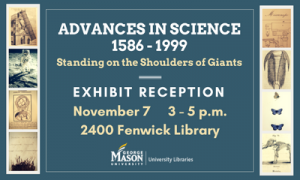 Bioscience. Space Exploration. Engineering. Information Technology. These are but a few of the rapidly advancing fields of science which affect our modern lives. Achievements in these disciplines were built – and continue to build – upon discoveries made by preceding generations of scientists. As Sir Issac Newton famously wrote, “If I have seen further, it is by standing on the shoulders of giants.”
Bioscience. Space Exploration. Engineering. Information Technology. These are but a few of the rapidly advancing fields of science which affect our modern lives. Achievements in these disciplines were built – and continue to build – upon discoveries made by preceding generations of scientists. As Sir Issac Newton famously wrote, “If I have seen further, it is by standing on the shoulders of giants.”
The exhibit Advances in Science 1586 -1999 Standing on the Shoulders of Giants explores the layered nature of scientific research, in which new knowledge is gained over the framework of each new discovery. In this exhibit, we see how the scientific method, first advocated by Sir Francis Bacon, informed the methodology of naturalist, Charles Darwin and later, the scientists who discovered DNA, Watson and Crick. In the field of applied mathematics, the theories espoused by Euclid during the 3rd Century, B.C. created a system of mathematical thinking that would not be expanded until the 19th century. And even as applied mathematics advances and paradigms shift, the work of Euclid remains relevant.
This exhibition explores the evolution of scientific thought through rare books, archival documents, and photographs. It examines two main branches of science: the life sciences and applied mathematics. Featuring the works of Euclid, Bacon, Spallanzani, Pasteur, Linnaeus, and Darwin, Advances in Science 1586 -1999 Standing on the Shoulders of Giants spans the period between the formulation of the scientific method to the construction of the International Space Station. A reception will be held on November 7, 3-5 p.m., Special Collections Research Center, 2400 Fenwick Library.
For more information, please contact Rebecca Bramlett, [email protected], 703-933-2058.
